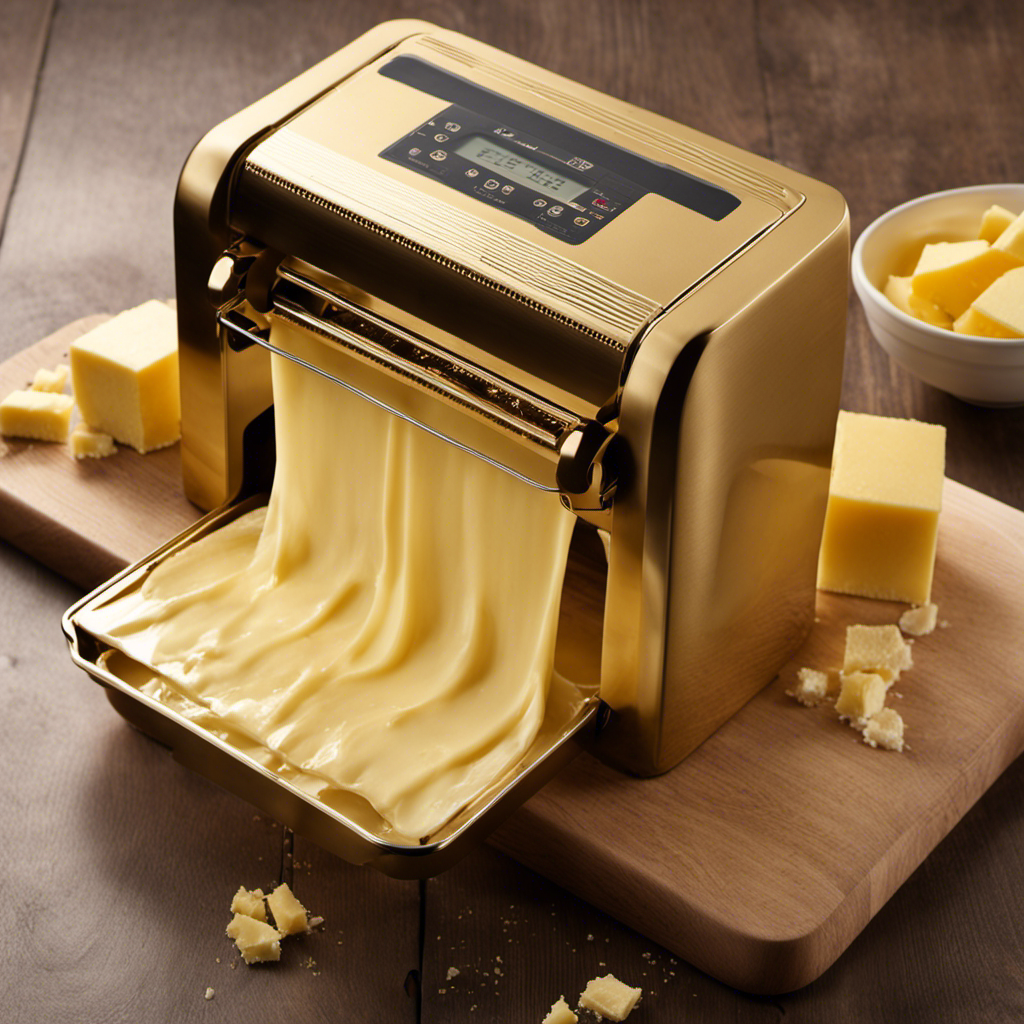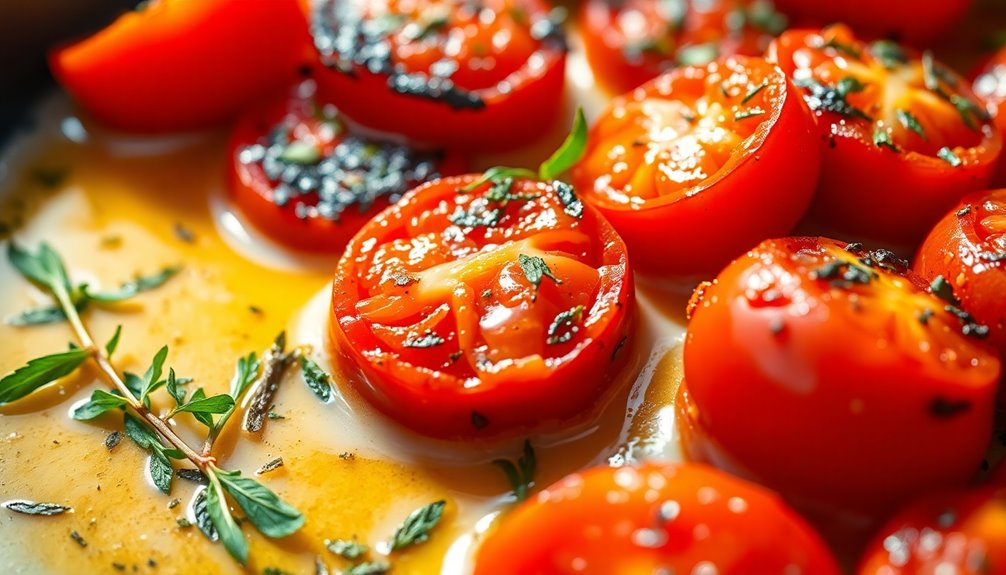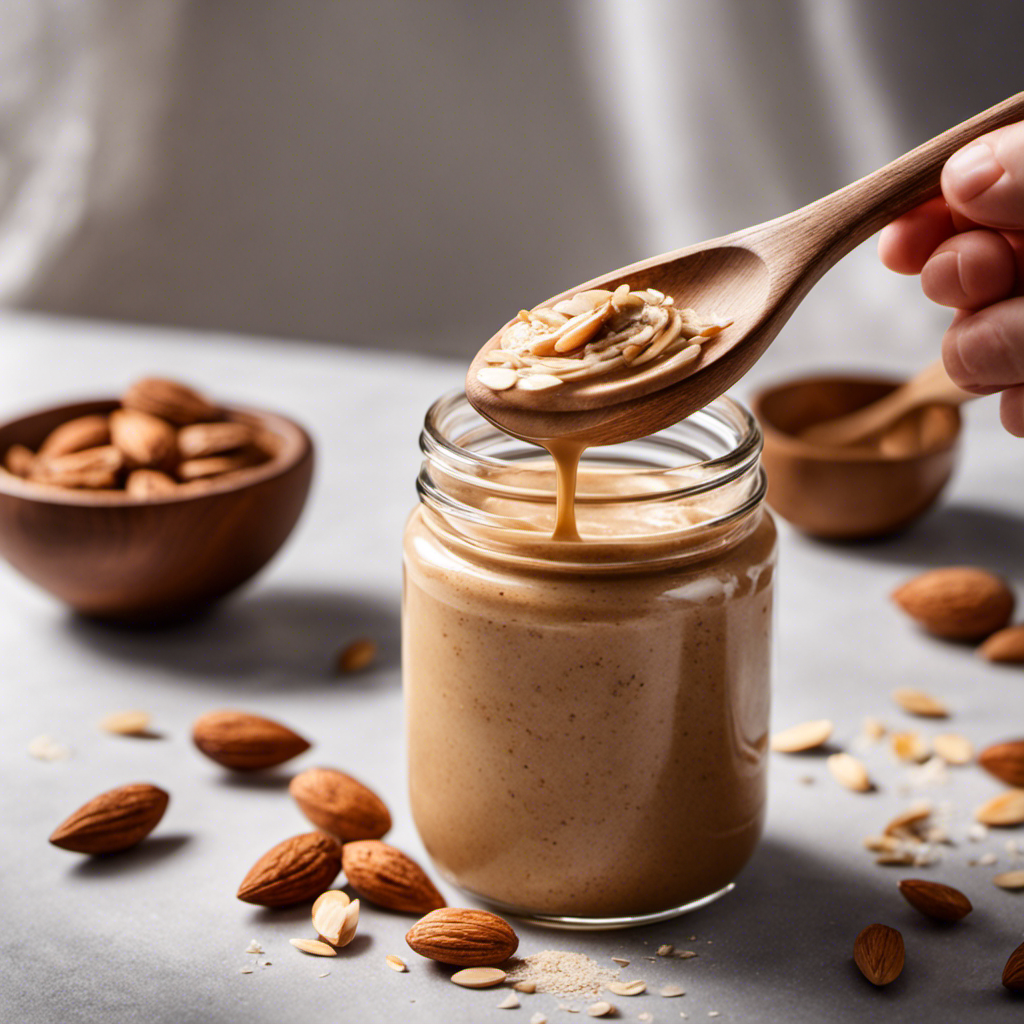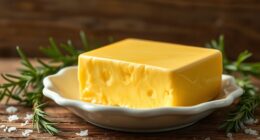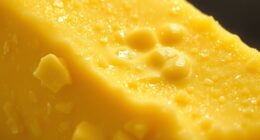I adore the luxury of a creamy, homemade ice cream, especially when it’s filled with the decadent tastes of chocolate and peanut butter.
And the best part? You don’t even need an ice cream maker to create this delectable treat.
In this article, I’ll guide you through the process of making homemade chocolate peanut butter ice cream from scratch, using simple ingredients and easy-to-follow steps.
Get ready to satisfy your sweet tooth and impress your taste buds with this delightful frozen dessert.
Key Takeaways
- Choose high-quality dark chocolate with at least 70% cocoa percentage
- Use unsalted, roasted peanuts for the best flavor
- Consider adding a dollop of smooth peanut butter for enhanced taste
- Experiment with different sweeteners and nut butter variations for unique flavors
Choosing the Right Ingredients
When making homemade chocolate peanut butter ice cream without an ice cream maker, it’s important to choose the right ingredients.
The first step is to select the perfect chocolate. I always opt for high-quality dark chocolate with a cocoa percentage of at least 70%. This ensures a rich and intense chocolate flavor that pairs perfectly with the creamy peanut butter.
Next, choosing the right peanuts is crucial. I recommend using unsalted, roasted peanuts for the best results. They should be fresh and aromatic, with a slight crunch. Avoid using salted peanuts, as they can overpower the delicate balance of flavors in the ice cream.
To enhance the peanut butter taste, you can also add a dollop of smooth peanut butter to the mix. This adds a creamy texture and a burst of nutty goodness to each spoonful.
Remember, when selecting your ingredients, always go for the highest quality options available. This will result in a homemade chocolate peanut butter ice cream that is smooth, creamy, and utterly irresistible.
Preparing the Chocolate Base
Once you’ve mixed the melted chocolate and creamy peanut butter together, you’ll want to slowly add in the sweetened condensed milk. This step is crucial in creating the smooth and creamy base for your homemade chocolate peanut butter ice cream. As you pour in the sweetened condensed milk, make sure to stir continuously to ensure everything is well combined.
Now, let’s dive into the details of preparing the chocolate base.
To achieve the perfect chocolate flavor, it’s important to choose the right cocoa powder. Opt for a high-quality cocoa powder that is unsweetened and preferably Dutch-processed. This will give your ice cream a rich and deep chocolate taste.
In addition to cocoa powder, using natural sweeteners can enhance the overall flavor of your ice cream. Consider substituting refined sugar with alternatives like honey or maple syrup. These natural sweeteners not only add sweetness but also bring their unique flavors to the mix.
To summarize, when preparing the chocolate base for your homemade ice cream, remember to:
- Slowly add the sweetened condensed milk while stirring continuously.
- Choose a high-quality unsweetened cocoa powder.
- Experiment with natural sweeteners like honey or maple syrup.
- Enjoy the process and have fun creating your own delicious chocolate peanut butter ice cream!
Incorporating the Peanut Butter
To achieve a creamy texture, it’s essential to smoothly incorporate the peanut butter into the chocolate base. This step is crucial in creating a delicious homemade chocolate peanut butter ice cream without an ice cream maker. Not only does it add richness and depth of flavor, but it also provides a velvety smoothness that will have you coming back for more.
When incorporating the peanut butter, there are a few techniques you can try. One method is to warm the peanut butter slightly to make it more pliable and easy to mix. Another option is to melt the peanut butter and drizzle it into the chocolate base, swirling it gently with a spatula or whisk. This creates beautiful ribbons of peanut butter throughout the ice cream.
Experimenting with different nut butters can also be a fun way to elevate your homemade ice cream. Consider incorporating almond butter, cashew butter, or even hazelnut spread for a unique twist on the classic chocolate peanut butter combination. The possibilities are endless when it comes to flavor combinations, so don’t be afraid to get creative.
Here is a table showcasing some delicious flavor combinations you can try:
| Nut Butter | Flavor Combination |
|---|---|
| Almond Butter | Dark Chocolate Almond |
| Cashew Butter | Salted Caramel Cashew |
| Hazelnut Spread | Chocolate Hazelnut Swirl |
Incorporating different nut butters and experimenting with flavor combinations is a great way to personalize your homemade ice cream and discover new taste sensations. So go ahead and let your imagination run wild with the endless possibilities!
Mixing in the Sweeteners
You can easily mix in the sweeteners by gently folding them into the chocolate base until well combined. Experimenting with different sweetener combinations is a fun way to personalize your homemade chocolate peanut butter ice cream. Here are some tips for achieving the perfect level of sweetness:
- Start with a small amount of sweetener and gradually add more to taste. This allows you to control the sweetness and prevent the ice cream from becoming overly sugary.
- Consider using a combination of different sweeteners, such as sugar and honey, to enhance the flavor profile of the ice cream.
- If you prefer a healthier option, try using natural sweeteners like maple syrup or agave nectar. These alternatives can add a unique depth of flavor to your ice cream.
- Don’t be afraid to get creative! Add a pinch of sea salt or a splash of vanilla extract to elevate the taste and balance the sweetness.
Adding the Dairy or Dairy-Free Alternative
Now, let’s explore the options for adding the dairy or dairy-free alternative to achieve the creamy texture in your homemade treat. When it comes to making homemade ice cream, you have a choice between using dairy or non-dairy options. Dairy-based ice cream typically uses milk and cream as the base, while non-dairy alternatives often use ingredients like coconut milk or almond milk.
To help you decide which option is best for you, I’ve created a table comparing the two:
| Dairy Options | Non-Dairy Options |
|---|---|
| Milk | Coconut Milk |
| Cream | Almond Milk |
| Yogurt | Cashew Milk |
Both dairy and non-dairy options can result in a creamy and delicious ice cream. It ultimately comes down to personal preference and dietary restrictions. If you’re lactose intolerant or following a vegan diet, non-dairy alternatives may be the way to go.
In addition to the base, you can also enhance the flavor of your ice cream by adding flavor extracts. Popular options include vanilla extract, almond extract, and mint extract. These extracts can add a burst of flavor to your homemade treat and take it to the next level. Experiment with different combinations to find your favorite flavor profile.
Whether you choose dairy or non-dairy options, and whichever flavor extracts you decide to add, making homemade ice cream allows you to customize your treat exactly the way you like it. So go ahead, get creative, and enjoy the creamy goodness!
Blending the Mixture Smooth
After blending the mixture smooth, you can pour it into the ice cream maker. This step is crucial in achieving a creamy and velvety texture for your homemade chocolate peanut butter ice cream.
Blending techniques play a significant role in ensuring all the ingredients are well incorporated, resulting in a deliciously balanced flavor. Here are some helpful blending techniques and troubleshooting tips to ensure success:
- Use a high-quality blender or food processor to achieve a smooth consistency.
- Start blending at a low speed and gradually increase it to prevent any splattering or spills.
- Scrape down the sides of the blender or food processor to ensure all the ingredients are properly mixed.
- If you encounter any lumps or chunks, continue blending until you achieve a smooth and uniform mixture.
By following these blending techniques, you’ll create a base that is perfectly blended and ready for the next step: chilling the ice cream base.
Chilling the mixture allows the flavors to meld together and gives the ice cream a smooth and creamy texture. So, let’s move on to the next step and get ready to chill our ice cream base.
Chilling the Ice Cream Base
Once the mixture is blended smooth, it’s time to chill the ice cream base for optimal flavor and texture. Chilling the base is an important step in the ice cream making process as it helps to prevent ice crystals from forming and ensures a creamy and smooth texture.
There are different methods to chill the base, but one of the easiest and most effective ways is using the freezer bag method.
To begin, transfer the blended ice cream base into a large resealable freezer bag. Make sure to leave some space at the top as the mixture will expand while freezing. Seal the bag tightly, pressing out any excess air to minimize the risk of freezer burn.
Next, place the bag flat in the freezer. It’s important to lay it flat to ensure even freezing and prevent any lumps or uneven textures. Leave it in the freezer for at least 4 hours, or preferably overnight, to allow the base to fully freeze and develop its flavors.
Once the ice cream base is thoroughly chilled, it’s time to move on to the next step: preparing the freezer-safe container.
Preparing the Freezer-Safe Container
Before transferring the chilled ice cream base into a freezer-safe container, be sure to choose a container that is large enough to hold the entire mixture. This step is crucial in order to prevent any spills or overflow when the ice cream starts to freeze. Here are some tips to help you prepare the perfect freezer-safe container:
- Use a container with a tight-fitting lid to prevent air from entering and causing ice crystals to form.
- Opt for a container made of plastic or metal, as they conduct cold temperature better than glass.
- Make sure the container is clean and free of any odors or residues that could affect the flavor of your ice cream.
- Consider using an airtight container specifically designed for ice cream, as it will help maintain the optimal texture and prevent freezer burn.
Now that you have chosen the right container, it’s time to think about alternative freezing methods. If you don’t have an ice cream maker, there are still ways to achieve a creamy and smooth texture. One option is to pour the chilled ice cream base into a shallow dish and place it in the freezer. Every 30 minutes, take it out and vigorously stir the mixture to break up any ice crystals that may have formed. Repeat this process until the ice cream reaches the desired consistency. Another option is to use a blender or food processor to whip the partially frozen mixture, creating a smoother texture. These alternative methods may require a bit more effort, but the end result will be worth it.
Pouring the Base Into the Container
When it comes to homemade ice cream, choosing the right container is crucial.
In this discussion, I will be exploring alternative container options that can be used instead of a traditional ice cream maker.
Additionally, I will delve into the freezing time and techniques that will ensure your ice cream freezes properly.
Alternative Container Options
If you don’t have an ice cream maker, you can use a loaf pan or a metal baking pan as an alternative container for your homemade chocolate peanut butter ice cream. This allows you to still enjoy the delicious treat without the need for specialized equipment.
Here are some alternative serving options and homemade ice cream toppings to enhance your ice cream experience:
- Serve your chocolate peanut butter ice cream in a waffle cone for a classic and crunchy treat.
- Top your ice cream with crushed peanuts for an added crunch and nutty flavor.
- Drizzle some warm homemade chocolate sauce over your ice cream for a decadent and indulgent touch.
- Sprinkle some mini chocolate chips on top of your ice cream for extra bursts of chocolate goodness.
These alternative serving options and homemade ice cream toppings will take your chocolate peanut butter ice cream to the next level, making it a delightful and unforgettable treat.
Freezing Time and Techniques
To achieve the perfect texture and consistency, it’s important to freeze your homemade chocolate peanut butter ice cream for at least 4-6 hours before serving.
Freezing is a crucial step in the ice cream-making process as it helps solidify the mixture and develop its creamy texture. However, improper freezing techniques can result in the formation of unwanted ice crystals, which can make your ice cream grainy and less enjoyable.
To prevent this, make sure to use an airtight container when freezing your ice cream. This will help minimize air exposure and prevent the formation of ice crystals. Additionally, placing a layer of plastic wrap directly on the surface of the ice cream before sealing the container can further prevent ice crystal formation.
Ensuring Proper Consistency
You can achieve a smooth and creamy consistency by properly freezing your homemade dessert. Maintaining the texture of your ice cream is crucial to the overall enjoyment of the final product.
Here are some tips to troubleshoot any issues that may arise:
- Make sure your freezer is set to the coldest temperature.
- Place your ice cream mixture in a shallow, wide container to freeze it faster and more evenly.
- Cover the container tightly with plastic wrap or a lid to prevent ice crystals from forming.
- Avoid frequent opening of the freezer door to maintain a consistent temperature.
By following these steps, you can ensure that your homemade ice cream turns out perfectly creamy and delicious.
Now that you have the base ready, let’s move on to the next step: swirling in additional mix-ins.
Swirling in Additional Mix-Ins
Mix in your additional mix-ins, such as chocolate chunks or crushed peanuts, until they are evenly distributed throughout the ice cream base.
This is where the real fun begins – personalizing your ice cream with mix-in options, variations, and flavor combinations. Whether you’re a fan of classic flavors or feeling adventurous, there are endless possibilities to explore.
One of my favorite mix-in options is adding chunks of rich, dark chocolate. As you scoop the ice cream into a container, simply sprinkle in some chocolate chunks and gently fold them in. The result is a delectable combination of creamy ice cream and bursts of chocolatey goodness.
If you’re a peanut lover like me, try adding some crushed peanuts for that extra crunch and nutty flavor.
But don’t limit yourself to just these mix-ins! Get creative and experiment with different ingredients. How about swirling in caramel sauce or adding a sprinkle of sea salt for a sweet and salty treat? You could even mix in some fresh fruit, like sliced strawberries or mashed bananas, for a refreshing twist.
Now that your mix-ins are evenly distributed throughout the ice cream base, it’s time to cover and freeze it.
Covering and Freezing the Ice Cream
After swirling in all the delicious mix-ins, it’s time to cover and freeze the ice cream. This is where the magic happens and the creamy goodness is created. Here are some freezing techniques to prevent ice crystals and ensure a smooth, velvety texture:
- Place the ice cream container in the freezer immediately after swirling in the mix-ins.
- Make sure the container is tightly covered with a lid or plastic wrap to prevent any air from entering.
- Place the container in the coldest part of the freezer to freeze as quickly as possible.
- Avoid opening the freezer door frequently, as this can cause temperature fluctuations and affect the freezing process.
By following these freezing techniques, you’ll be able to keep the ice cream from developing ice crystals and maintain its creamy texture. It’s important to note that the freezing time may vary depending on your freezer’s temperature, but typically it takes about 4-6 hours for the ice cream to fully freeze.
Now that the ice cream is covered and safely tucked away in the freezer, it’s time to move on to the next step: stirring the ice cream during the freezing process.
Stirring the Ice Cream During the Freezing Process
During the freezing process, it’s important to periodically stir the ice cream to prevent the formation of ice crystals. Mixing techniques play a crucial role in achieving that creamy, smooth texture we all love in ice cream. As the ice cream mixture freezes, ice crystals start to form. Stirring breaks up these crystals and incorporates air into the mixture, resulting in a lighter and smoother ice cream.
To begin, make sure you have a sturdy spoon or spatula. As the ice cream freezes, it becomes harder to stir, so you’ll need something durable to handle the task. Start by scraping the sides of the container to prevent any icy build-up. Then, give the mixture a good stir from bottom to top. This helps distribute the cold temperature evenly throughout, preventing any ice crystals from forming.
The frequency of stirring depends on the freezing temperatures. If you’re using a conventional freezer, you’ll need to stir every 30 minutes to an hour. However, if you have a deep freeze or an ultra-cold freezer, you may only need to stir every couple of hours. The key is to keep an eye on the texture and consistency of the ice cream.
Testing the Ice Cream for Desired Consistency
To check if your ice cream has reached the desired consistency, give it a taste and see if it has a smooth and creamy texture. This is the exciting part of the ice cream making process – testing the flavor combinations and experimenting with different mix-in options.
Here are some tips to help you determine if your homemade chocolate peanut butter ice cream is ready to be enjoyed:
-
Take a spoonful of the ice cream and let it melt slightly on your tongue. Pay attention to the texture – it should feel rich and velvety, not icy or grainy.
-
Notice the flavor profile. The chocolate should be rich and intense, while the peanut butter should be creamy and nutty. The flavors should complement each other, creating a harmonious blend.
-
Check the consistency. The ice cream should hold its shape when scooped, but also be easily scoopable and not too firm. It should have a luxurious melt-in-your-mouth quality.
-
Consider the overall experience. Does the ice cream make you want to take another bite? Does it bring a smile to your face? A well-made ice cream should not only taste delicious but also bring joy and satisfaction.
Serving and Enjoying the Homemade Ice Cream
Now that your homemade ice cream is ready, grab a spoon and savor every creamy bite. Serving and enjoying your creation is the best part of making homemade ice cream. Whether you’re serving it to guests or indulging in a solo treat, here are some serving tips and garnish ideas to elevate your ice cream experience.
To make your ice cream presentation visually appealing, consider using a variety of serving dishes. A classic ice cream bowl or cone is always a good choice, but you can also get creative and serve your ice cream in mason jars, cookie cups, or even edible chocolate bowls. Presentation is key, so don’t be afraid to experiment!
Now, let’s talk about garnish ideas. Adding toppings to your ice cream not only enhances the flavor but also adds texture and visual appeal. Here’s a table to give you some inspiration:
| Topping | Description |
|---|---|
| Hot Fudge | Rich and gooey chocolate sauce |
| Crushed Oreos | Adds a delicious crunch |
| Chopped Nuts | Provides a satisfying nutty flavor |
Feel free to mix and match toppings to create your own unique ice cream masterpiece. Don’t forget the whipped cream, cherry on top, or a drizzle of caramel for that extra touch of indulgence. So go ahead, serve your homemade ice cream with style and enjoy every delectable spoonful.
Storing the Remaining Ice Cream for Later Use
If you have any leftover ice cream, store it in an airtight container in the freezer for future enjoyment. Freezing ice cream properly is essential to prevent the formation of ice crystals and maintain its creamy texture.
Here are some freezing tips to keep your ice cream delicious:
-
Choose the right container: Opt for a container that is airtight and freezer-safe. This will help prevent any unwanted odors or flavors from seeping into your ice cream.
-
Fill the container properly: Leave some space at the top of the container to allow for expansion as the ice cream freezes. This will help prevent the lid from popping off and air from entering, which can lead to freezer burn.
-
Protect the surface: To prevent ice crystals from forming on the surface of your ice cream, place a piece of plastic wrap directly on top of the ice cream before sealing the container. This creates a barrier between the ice cream and the air.
-
Store it in the back of the freezer: The back of the freezer is the coldest part, so it’s the best place to store your ice cream. Avoid storing it near the door, as the temperature fluctuates more there.
Frequently Asked Questions
Can I Use Natural Peanut Butter Instead of Regular Peanut Butter?
Sure, you can use natural peanut butter instead of regular peanut butter in homemade chocolate peanut butter ice cream. Just be aware that natural peanut butter may have a different texture and taste. Adjust the sweetness level to your preference.
Can I Use a Substitute for Sugar, Such as Honey or Maple Syrup?
Sure, you can use substitutes like honey or maple syrup instead of sugar in homemade ice cream. They add a natural sweetness and unique flavor, making your ice cream even more delicious and healthier.
How Long Does It Take for the Ice Cream Base to Chill in the Refrigerator?
The chilling time for the ice cream base in the refrigerator is crucial for achieving the perfect texture. It allows the mixture to cool and set, resulting in a creamy and smooth homemade ice cream.
Can I Use Almond Milk or Coconut Milk as a Dairy-Free Alternative?
Yes, you can use almond milk or coconut milk as a dairy-free alternative for making ice cream. They provide a creamy texture and delicious flavor. Other dairy-free alternatives include soy milk and cashew milk.
How Long Should I Stir the Ice Cream During the Freezing Process?
During the freezing process, it’s important to stir the ice cream every 30 minutes to prevent ice crystals from forming. This will help achieve a smooth texture. Don’t forget to add mix ins at the right time to avoid compromising the freezing process.
Conclusion
As I take the first creamy spoonful of homemade chocolate peanut butter ice cream, a wave of satisfaction washes over me.
The velvety chocolate base, swirled with ribbons of rich peanut butter, dances on my tastebuds, creating a symphony of flavors.
The sweetness is perfectly balanced, thanks to the addition of just the right amount of sweeteners.
The absence of an ice cream maker doesn’t hinder the process; the stirring and freezing method works like magic.
With each bite, I am transported to a world of decadence and indulgence.
This homemade treat is truly a masterpiece, a symbol of my love for dessert and my dedication to creating something extraordinary.

